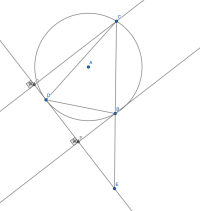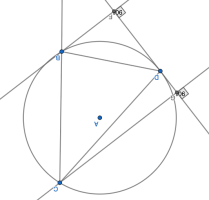rocketFrog
New member
- Joined
- Aug 15, 2022
- Messages
- 15
Hi everyone,
Problem statement:
Triangle CBD is inscribed in a circle. From point D, a tangent line is drawn, which intersects the extension of side CB at point E. Two normals from the points B and C are drawn onto the tangent line, the shorter of which is 6cm in length. Calculate the area of the trapezoid formed by the two normals, side CB and a part of the tangent if CB = 5cm, DE = 5[imath]\sqrt{6}[/imath] cm and BF = 6cm.

The formula for the area of a trapezoid is [imath]A = \frac{(a+c)h}{2}[/imath] where a and c are the bases and h is a height. Now, the trapezoid in question is a right trapezoid, if we flip the image for 180º, we have:

So we already have the longer side CB, and shorter base FB, to calculate the area we need the lengths of longer base GC and height GF.
Triangles GEC and FEB since they both have a 90º angle and they share the angle at point E.
This is pretty much where I'm stuck. I've tried looking at triangles FEB and FDB but was not able to prove similarity between the two.
Any help would be appreciated!!
Problem statement:
Triangle CBD is inscribed in a circle. From point D, a tangent line is drawn, which intersects the extension of side CB at point E. Two normals from the points B and C are drawn onto the tangent line, the shorter of which is 6cm in length. Calculate the area of the trapezoid formed by the two normals, side CB and a part of the tangent if CB = 5cm, DE = 5[imath]\sqrt{6}[/imath] cm and BF = 6cm.

The formula for the area of a trapezoid is [imath]A = \frac{(a+c)h}{2}[/imath] where a and c are the bases and h is a height. Now, the trapezoid in question is a right trapezoid, if we flip the image for 180º, we have:

So we already have the longer side CB, and shorter base FB, to calculate the area we need the lengths of longer base GC and height GF.
Triangles GEC and FEB since they both have a 90º angle and they share the angle at point E.
This is pretty much where I'm stuck. I've tried looking at triangles FEB and FDB but was not able to prove similarity between the two.
Any help would be appreciated!!
